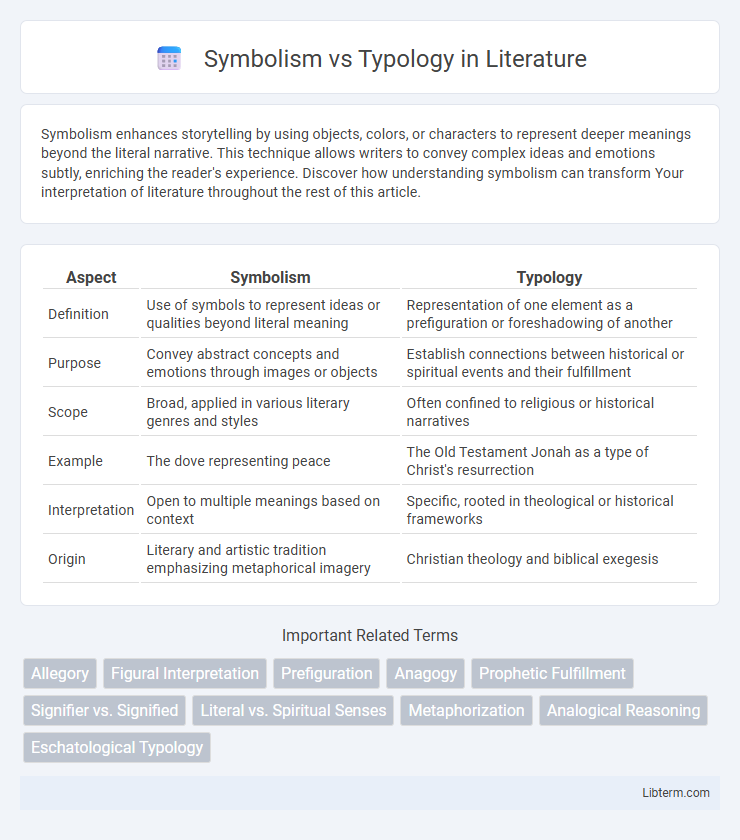Symbolism enhances storytelling by using objects, colors, or characters to represent deeper meanings beyond the literal narrative. This technique allows writers to convey complex ideas and emotions subtly, enriching the reader's experience. Discover how understanding symbolism can transform Your interpretation of literature throughout the rest of this article.
Table of Comparison
| Aspect | Symbolism | Typology |
|---|---|---|
| Definition | Use of symbols to represent ideas or qualities beyond literal meaning | Representation of one element as a prefiguration or foreshadowing of another |
| Purpose | Convey abstract concepts and emotions through images or objects | Establish connections between historical or spiritual events and their fulfillment |
| Scope | Broad, applied in various literary genres and styles | Often confined to religious or historical narratives |
| Example | The dove representing peace | The Old Testament Jonah as a type of Christ's resurrection |
| Interpretation | Open to multiple meanings based on context | Specific, rooted in theological or historical frameworks |
| Origin | Literary and artistic tradition emphasizing metaphorical imagery | Christian theology and biblical exegesis |
Defining Symbolism and Typology
Symbolism represents ideas or qualities through symbols, using objects, characters, or actions to convey deeper meanings beyond the literal. Typology, often within theological contexts, interprets events, people, or institutions in the Old Testament as prefigurations or foreshadows of New Testament realities, establishing a divine pattern. Both methods enrich textual interpretation by revealing layered significance, but symbolism emphasizes metaphorical representation while typology focuses on prophetic fulfillment.
Historical Contexts of Symbolism and Typology
Symbolism in historical contexts often embodies cultural or religious meanings through objects, colors, or actions, reflecting the beliefs and values of specific societies, such as the use of the lamb symbolizing innocence in early Christian art. Typology, particularly in biblical studies, interprets historical events or figures as prefigurations or foreshadowings of future ones, like Moses serving as a type of Christ in Judaic tradition. Both approaches deepen understanding by connecting tangible elements or past occurrences to broader spiritual or thematic concepts within their historical frameworks.
Core Differences between Symbolism and Typology
Symbolism represents objects, actions, or events that signify abstract ideas or qualities, often conveying meaning through metaphorical or arbitrary association. Typology specifically involves the prophetic foreshadowing in religious contexts, where an earlier event, person, or institution (type) prefigures and is fulfilled by a later event, person, or institution (antitype). Core differences lie in symbolism's broad metaphorical use versus typology's structured, chronological foreshadowing with fulfillment in theological narratives.
Symbolism in Literature and Art
Symbolism in literature and art utilizes objects, characters, or colors to represent deeper meanings and abstract ideas beyond their literal sense, often evoking emotional or spiritual responses. This technique allows creators to convey complex themes such as love, death, or morality indirectly, enriching the interpretative depth of a work. Unlike typology, which relies on predefined religious or historical patterns, symbolism embraces subjective and multifaceted interpretations tied to cultural or personal contexts.
Typology in Religious and Theological Studies
Typology in religious and theological studies interprets events, persons, or institutions as prefigurations or foreshadowings of later fulfillments, especially within Christian theology where Old Testament figures like Moses are seen as types of Christ. This method reveals divine patterns and continuity in sacred texts, emphasizing prophetic relationships across scripture. Unlike general symbolism, typology is grounded in historical and doctrinal frameworks that validate its predictive and revelatory significance.
Functions of Symbolism vs Typology in Interpretation
Symbolism functions to convey abstract ideas and theological concepts through concrete images or signs, enhancing emotional and spiritual engagement in biblical interpretation. Typology serves as a prophetic framework, linking Old Testament events or figures as foreshadows of New Testament fulfillment, providing a hermeneutical method for understanding divine plan continuity. While symbolism emphasizes thematic expression, typology facilitates chronological and salvific connections within scriptural narrative interpretation.
Examples of Symbolism in Sacred Texts
Symbolism in sacred texts often uses tangible objects or actions to represent deeper spiritual truths; for example, the dove in the Bible symbolizes the Holy Spirit and peace. Another prominent example is the use of light to signify purity, divinity, and knowledge, such as God described as light in the Gospel of John. These symbolic representations convey complex theological concepts and sacred meanings beyond literal interpretation.
Applications of Typology in Christian Traditions
Typology in Christian traditions serves as a hermeneutical tool that interprets Old Testament events, persons, or institutions as prefigurations of New Testament fulfillment, enhancing theological understanding and liturgical practice. Applications of typology are evident in sacraments, such as baptism and Eucharist, where Old Testament figures like Moses and the Passover lamb are seen as types foreshadowing Christ's redemptive work. This interpretive method deepens scriptural coherence, influences Christian art, and reinforces doctrinal teachings within various denominations.
The Impact of Symbolic and Typological Readings
Symbolic and typological readings profoundly shape biblical interpretation by offering layered meanings that connect historical events with spiritual truths. Symbolism highlights abstract concepts through imagery, while typology reveals prefigurations of Christ and salvation history within Old Testament narratives. This dual approach enriches theological understanding, deepens scriptural engagement, and fosters a dynamic relationship between text and faith.
Contemporary Perspectives on Symbolism and Typology
Contemporary perspectives on symbolism emphasize its dynamic role in conveying complex meanings through symbols that evolve with cultural contexts, enhancing interpretative depth. Typology is increasingly regarded as a structured framework that connects historical events and figures with symbolic representations, facilitating theological and literary analysis. Both approaches contribute to modern hermeneutics by blending cognitive and cultural dimensions, enriching understanding in religious studies and literary criticism.
Symbolism Infographic

 libterm.com
libterm.com